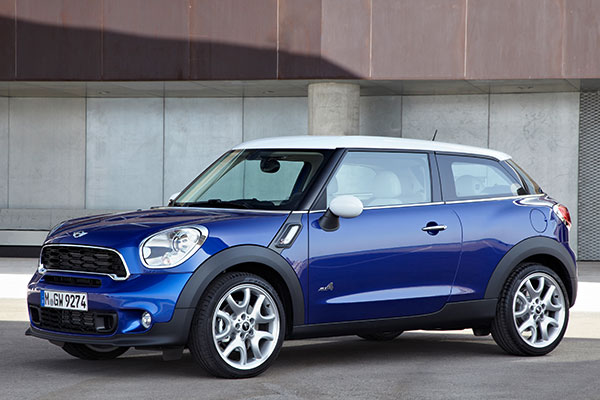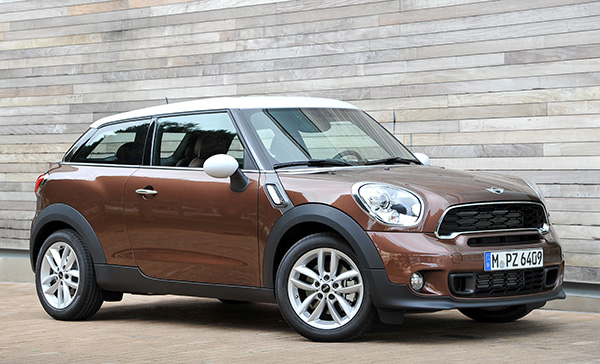

an account. You can:
Access your saved cars on any device.
Receive Price Alert emails when price changes,
new offers become available or a vehicle is sold.


Model Overview of The Mini Paceman's For Sale in Middletown, CT
2014 Mini Paceman Information
2014 Mini Paceman
Yet another Mini goes on sale next year. The Mini Paceman, thought to be a 2014 model, is sort of a coupe version of the big Mini Countryman. Sort of a little big man.
Product proliferation is a term you hear a lot of on the business side of the auto industry these days. For car buyers that translates into a flood of more and more new models every year. Having more choices is better for consumers, though it can make choosing among them more stressful. Nowhere is product proliferation more apparent than at Mini. Since its U.S. launch, barely a decade ago, the British maker has introduced all manner of coupes, hatchbacks, convertibles and even crossovers, in the case of the Countryman.
The Mini Countryman delivered a number of firsts for Mini: its first four-door, its first use of all-wheel drive, and the biggest product ever to wear the Mini badge. So it should be no surprise Mini has come up with a spin-off sharing the Countryman platform.
The long-anticipated Paceman was revealed at the 2012 Paris Motor Show and will soon become the seventh distinct model in the Mini line-up.
The overall look of the three-door Paceman wont come as a surprise to those familiar with Mini and, in particular, the Countryman. From the windshield forward, in fact, the two are essentially identical, down to the headlight layout and hexagonal grille.
But Paceman is more than just a coupe version of the Countryman. The doors are stretched, of course, but the helmet-like roof now has a downward slope that is reminiscent of the smaller Mini Coupe. A new chrome beltline, meanwhile, rises up as if to meet the roof.
Perhaps the most distinctive design feature is the use of horizontal taillights for the first time by the brand. They frame the Mini brand name which boldly goes where no Mini badge has gone: in the center of the hatch.
The Paceman interior is borrowed from the Countryman, starting with the massive mid-dash speedometer and gauge cluster. Also borrowed from the Countryman crossover: the distinctively flexible Mini Center Rail storage system that can be adapted to a variety of needs with different holders and bins. The back seats can recline on the new Paceman. But the sporty new model, appropriately, gets new sport seats. And, in a clear nod to American expectations, Mini has moved the window switches onto the doors, rather than locating them at the base of the center stack.
As one might expect, Mini will offer a vast array of customizable features, including the traditional selection of roof decals.
The Paceman powertrain will come standard with front-wheel drive, but Minis All4 all-wheel-drive will be available on all variants, including Cooper, Cooper S, Cooper D and Cooper SD Paceman. The base Mini Cooper Paceman package will feature a 1.6-liter four-cylinder making 122 horsepower and 118 pound-feet of torque, the Cooper S bolting on a turbocharger that bumps the numbers to 184 hp and 177 lb-ft. Thats enough to slash 0 to 60 times from 10.4 seconds to 7.5, according to Mini numbers. All versions will offer a 6-speed stick that can be substituted for the stock 6-speed automatic.
It remains to be seen if the Cooper D and SD diesel versions will make a U.S. appearance, though thats not in the plans for now. But Mini did confirm that a John Cooper Works Paceman, essentially the same powertrain package as in the similarly named Countryman, will follow, turning out 218 hp and 221 lb-ft.
Mini promises a go kart feeling and the new three-door will feature a lowered sports suspension, though a standard ride height can be ordered as a no-cost option. The front suspension is a MacPherson Strut layout with a multi-link rear design.
For those looking at the functional side, the Paceman will seat four adults and boasts a cargo capacity of 11.5 cubic feet, which increases to 38.5 cubic feet with the rear seats folded down.
These specs are for the European market and wont be finalized for the American market until closer to launch in the second quarter of 2013.
2013 Mini Paceman Information
2013 Mini Paceman
Mini has become one of autodom's foremost illusionists, using essentially the same silk handkerchief and top hat to conjure up new tricks, each a variation on its predecessor, each a surprise. Since its 2002 revival, BMW's Mini subsidiary has expanded its model menu steadily, repurposing the basic elements. Thus the current lineup represents two versions of one basic front-drive architecture and three versions of one engine across a range of seven models, with more on the way.
The 2013 Mini Paceman is the latest addition to the family, and it's another indication that the product planners don't feel constrained by definitions. The dictionary says that mini refers to something small of its kind. The revivalist BMW Mini of 2002 was certainly small, but it was almost two feet longer, a foot wider, and nearly a thousand pounds heavier than the original Mini Cooper.
This may have mattered to purist devotees of the original 1960s Mini, but it didn't matter to those who flocked to the BMW sequel, a jaunty three-door hatchback that was distinctively cute and very entertaining to drive.
However, when BMW began expanding on the theme, literally, with Minis that weren't quite so mini, many of those who bought the three-door versions became purists in their own right, haughtily dismissing the variants as heresy. (The reaction is similar to the response of Porsche 911 owners to the company's introduction of the Cayenne SUV.)
By that reckoning, the Paceman could be viewed as one of the more heretical of the variants. It's based on the same foundations that support the five-door Countryman, Mini's version of a small scale crossover SUV, and while it's not quite as tall and has only three doors, it is nevertheless substantially bigger than the basic three-door hatchback, which is now known as the Mini Hardtop.
While this may provoke disdain from the latter day purists, to those who harbor no preconceptions the Paceman may well look like the perfect Mini. It successfully expands the dimensions of the basic Mini Hardtop without spoiling the smaller car's distinctive proportions, its front end styling is unmistakably Mini, the increased size yields a corresponding increase in interior volume, which pays off in a back seat that is actually habitable by people, rather than just parcels.
Another plus: like the Countryman, the Paceman offers the option of all-wheel drive (Mini calls its system All4), the only two Minis with this feature.
Other elements of the Paceman powertrains are tried and true. Engine choices boil down to a 1.6-liter 16-valve four-cylinder in three states of tune: naturally aspirated in the base version, turbocharged in the other two, sending power to the front wheels via either a 6-speed manual transmission or 6-speed automatic. The All4 option is offered only with the turbocharged engines.
Increased dimensions add up at the scales, and with a minimum curb weight of 2940 pounds, the non-turbo version of the 1.6-liter is a little anemic towing a Mini as big as the Paceman. The Paceman S gets a 181-horsepower turbocharged version of the engine, which generates enough thrust to produce respectable acceleration, and there's also the John Cooper Works (JCW) edition, raising the output ante to 208 horsepower for about $5000, roughly $158 per pony.
In addition to more interior volume, increasing the practicality index versus the basic Hardtop model, the Paceman's furnishings are high quality, and like the rest of the Mini family the inside story blends design elements from the 1960s with contemporary features such as navigation and contemporary telematics, as well as sporty bucket seats.
The latter day Mini has thrived on its brash individuality, but the trait that sustains its popularity is an exceptionally high fun-to-drive index. Although the Paceman weighs in about 400 pounds heavier than the smaller Hardtop, driver gratification is still a strong suit.


